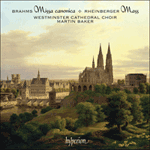Geistliches Lied Op 30 was composed in 1856, so that despite the misleading opus number it in fact predates both the ‘Ave Maria’ and the setting of Psalm 13. Published in 1864, the first performance was given in St James’s Church, Chemnitz, on 2 July 1865. The textures of this setting are predominantly canonic, with overlapping entries arriving at both the second above and the ninth below. It is the austerity of style which links this piece firmly with the motets, yet the overall mood can be seen as in some ways preparatory for the ‘German Requiem’. The final ‘Amen’, with its glorious, aching suspensions, comes as a poignant emotional release after the comparative reserve of the setting as a whole.
from notes by Julian Haylock © 1991
Geistliches Lied op. 30 fut composé en 1856. En dépit du numéro d’opus qui induit en erreur, il date en fait d’avant l’«Ave Maria» et la mise en musique du Psaume 13. Il fut représenté pour la première fois dans l’église de Saint Jacques à Chemnitz, le 2 juillet 1865. Nous trouvons les textures de cette mise en musique de prédominance canonique, avec des entrées imbriquées arrivant à la fois à la seconde supérieure et la neuvième inférieure. Ce qui apparente fermement cette œuvre avec les motets, c’est l’austérité du style, et cependant le mode général peut être considéré en quelque sorte comme une préparation au «Requiem allemand». L’Amen final, avec ses glorieuses suspensions douloureuses, arrive comme une poignante libération d’émotion après la relative réserve de l’ensemble de cette mise en musique.
extrait des notes rédigées par Julian Haylock © 1991
Français: Alain Midoux
Das
Geistliches Lied op. 30 wurde 1856 komponiert, ist also trotz der irreführenden Werksnummer nicht nur älter als das „Ave Maria“, sondern auch älter als die Vertonung des 13. Psalms. Es wurde 1864 veröffentlicht, und die Uraufführung fand am 2. Juli 1865 in der Chemnitzer Jakobskirche statt. Diese Vertonung ist in der Hauptsache kanonisch aufgebaut, mit überlappenden Einsätzen, die sowohl eine Sekunde nach oben, als auch eine None nach unten versetzt erfolgen. Es ist seine stilistische Strenge, die dieses Stück unverrückbar mit den Motetten verknüpft, während seine Grundstimmung in gewisser Hinsicht als Vorbereitung auf das „Deutsches Requiem“ gesehen werden kann. Das „Amen“ mit seinen herrlich schmerzlichen Vorhalten wirkt zum Abschluß der insgesamt vergleichsweise zurückhaltenden Vertonung als ergreifende emotionale Erlösung.
aus dem Begleittext von Julian Haylock © 1991
Deutsch: Anne Steeb/Bernd Müller


 Brahms & Bruckner: Motets
Brahms & Bruckner: Motets Brahms & Rheinberger: Masses
Brahms & Rheinberger: Masses
